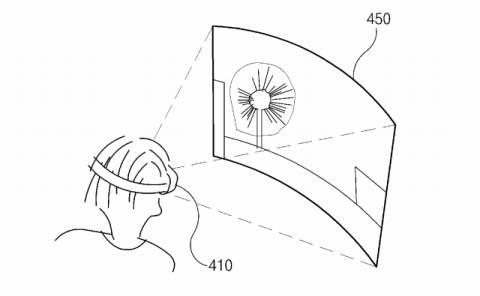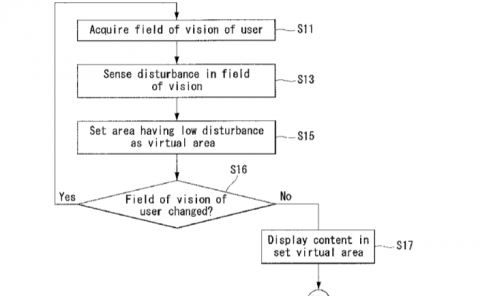Samsung Patent | Method and Apparatus for Processing Image
Patent: Method and Apparatus for Processing Image
Publication Number: 20190037196
Publication Date: 2019-01-31
Applicants: Samsung

Abstract
An apparatus for processing an image includes: a first display of which an optical focal distance is a first distance; a second display of which an optical focal distance is a second distance; a processor configured to determine a first value of a first pixel of the first display and a second value of a second pixel of the second display according to a depth value of a first image to be output; and an image converging member configured to overlap the first pixel and the second pixel and output the first image corresponding to the depth value.
Background
Electronic devices and display devices capable of generating a virtual reality (VR) environment have been developed and receive increasing attention. Techniques for realizing augmented reality (AR) and mixed reality (MR) as the next stage of virtual reality (VR) have been studied.
Unlike virtual reality (VR) in which a full virtual world is realized, augmented reality (AR) is a display technology that further increases the effect of reality by superimposing (or combining) a virtual object or information about the environment of the real world on a view of the environment of the real world. While virtual reality (VR) may be applied only to limited fields such as games or virtual experience, AR has the advantage that it may be applied to various real environments. In particular, augmented reality (AR) is attracting attention as a next generation display technology suitable for a ubiquitous environment or an Internet of Things (IoT) environment. Augmented reality (AR) is an example of mixed reality (MR) showing a mixture of the real world and the virtual world (e.g., additional information).
Thus, the technological field for processing and displaying three-dimensional images has gradually expanded. Accordingly, a user-friendly three-dimensional image processing method or a three-dimensional image display method is desirable.
Summary
One or more exemplary embodiments provide methods and apparatuses for outputting a user-friendly image by processing an image. One or more exemplary embodiments also provide methods and apparatuses for outputting a user-friendly three-dimensional image that does not cause dizziness to a viewer.
Additional aspects will be set forth in part in the description which follows and, in part, will be apparent from the description, or may be learned by practice of the presented embodiments.
According to an aspect of an exemplary embodiment, there is provided of an apparatus for processing an image includes: a first display of which an optical focal distance is a first distance; a second display of which an optical focal distance is a second distance; a processor configured to determine a first value of a first pixel of the first display and a second value of a second pixel of the second display according to a depth value of a first image to be output; and an image converging member configured to overlap the first pixel and the second pixel and output the first image corresponding to the depth value.
The processor may control a range of the depth value, at which the first pixel of the first display and the second pixel of the second display are simultaneously displayed, to be within a predetermined range.
When the second distance is greater than the first distance, an upper limit of the predetermined range may be smaller than the second distance, and a lower limit of the predetermined range may be greater than the first distance.
The first distance and the second distance may be determined according to physical characteristics of the first display and the second display, respectively.
The second distance may be greater than the first distance, and the processor may determine the first value of the first pixel to be greater than the second value of the second pixel in response to an average value of the first distance and the second distance being greater than the depth value.
The second distance may be greater than the first distance, and the processor may determine a weight applied to the first value of the first pixel to be greater than a weight applied to the second value of the second pixel in response to an average value of the first distance and the second distance being greater than the depth value.
The first value of the first pixel may include a brightness value of the first pixel and the second value of the second pixel includes a brightness value of the second pixel.
The processor may generate an additional image in which a binocular parallax is reflected on the first image, and the image converging member may output the additional image.
The first image may be output to one of a left eye and a right eye of a user and the additional image may be output to another one of the left eye and the right eye of the user.
The processor may determine the first value of the first pixel and the second value of the second pixel corresponding to the depth value according to a look up table (LUT).
According to an aspect of another exemplary embodiment, there is provided a method for processing an image including: obtaining a depth value of a first image to be output; determining, based on the depth value, a first value of a first pixel of a first display of which an optical focal distance is a first distance and determining a second value of a second pixel of a second display of which an optical focal distance is a second distance; and overlapping the first pixel and the second pixel to output the first image corresponding to the depth value.
The determining may include controlling a range of the depth value at which the first pixel of the first display and the second pixel of the second display are simultaneously displayed to be within a predetermined range.
When the second distance is greater than the first distance, an upper limit of the predetermined range may be smaller than the second distance, and a lower limit of the predetermined range may be greater than the first distance.
The first distance and the second distance may be determined according to a physical characteristics of the first display and the second display, respectively.
The second distance may be greater than the first distance, and the determining may include determining the first value of the first pixel to be greater than the second value of the second pixel in response to an average value of the first distance and the second distance being greater than the depth value.
The second distance may be greater than the first distance, and the determining may include determining a weight applied to the first value of the first pixel to be greater than a weight applied to the second value of the second pixel in response to an average value of the first distance and the second distance being greater than the depth value.
The first value of the first pixel may include a brightness value of the first pixel and the second value of the second pixel includes a brightness value of the second pixel.
The method may further include outputting an additional image in which a binocular parallax is reflected on the first image.
The first image may be output to one of a left eye and a right eye of a user and the additional image may be output to another one of the left eye and the right eye of the user.
The determining may include determining the first value of the first pixel and the second value of the second pixel corresponding to the depth value according to a look up table.
According to an aspect of another exemplary embodiment, there is provided a non-transitory computer-readable recording medium that stores a program which, when executed by a computer, implements the above method.
According to an aspect of another exemplary embodiment, there is provided a method of processing an image, including: receiving an input image including a depth value; modulating the depth value to be within a predetermined range based on a first optical focal distance of a first display and a second optical focal distance of a second display; determining a first value of a first pixel of the first display and a second value of a second pixel of the second display according to the modulated depth value, the second pixel having a position corresponding to a position of the first pixel; and outputting an output image based on the value of the first pixel and the value of the second pixel.
The method may further include normalizing the depth value prior to the modulating.
The depth value may be modulated by using depth value modulation data stored in a look up table.
The LUT may be provided by using a depth value modulation function including a sigmoid function.



